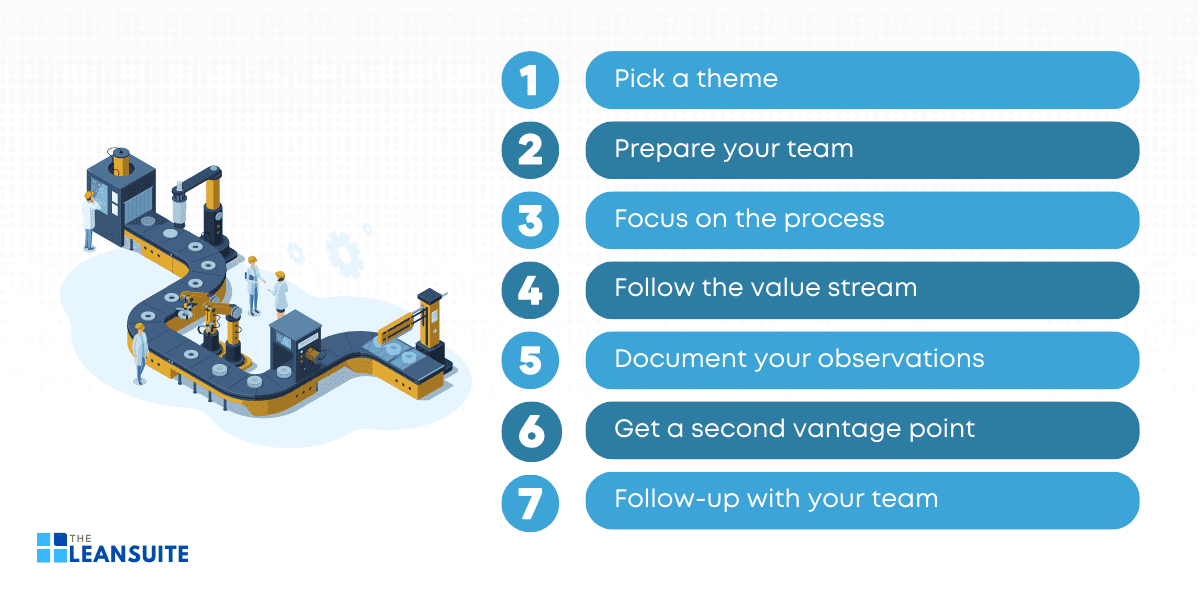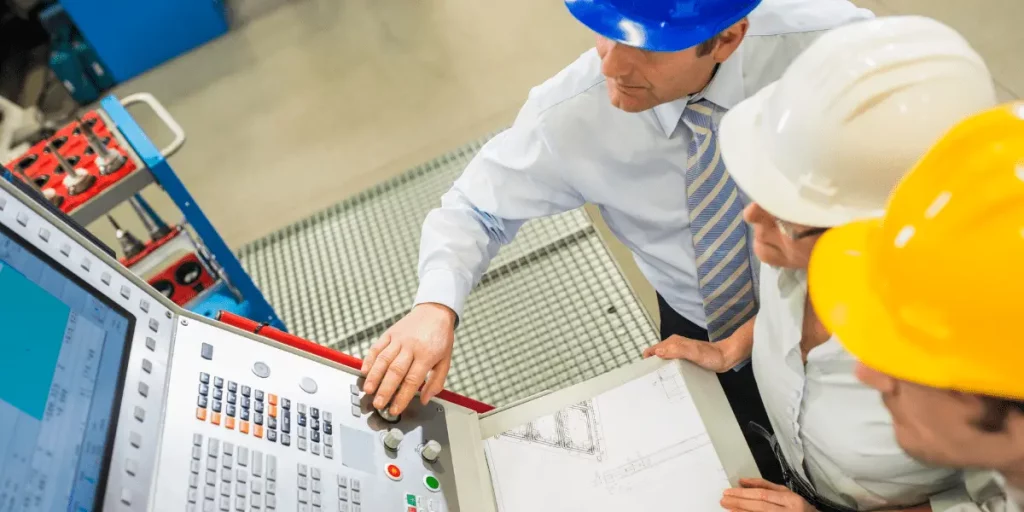Instead of sitting in your office and expecting different results from your team, go and see where the real work happens. In today’s blog, we list the seven steps you should follow to perform an effective Gemba walk. But first, let’s get into what a Gemba walk is.
What is a Gemba Walk?
Gemba is a Japanese term that translates to “the real place” and it is where the real work happens. For instance, for singers, the “Gemba” is the recording studio. For soccer players, the “Gemba” is the soccer field. So, for manufacturers, the real place where work happens is the shop floor.
A Gemba walk is a physical tour of the shop floor and it is a concept that was developed by Taiichi Ohno. He was a Japanese industrial engineer and businessman who is often considered the father of just-in-time production, or also known as the Toyota Production System (TPS). The purpose of a Gemba walk is to bring managers and leaders to the shop floor to observe production processes as they happen, engage with employees, gain knowledge about the work process, and identify continuous improvement opportunities.
The 3 Key Elements of a Gemba Walk
1. Go and see
The Gemba walk was designed specifically to encourage managers and leaders at every level to take regular tours around the shop floor and participate in identifying waste or inefficiencies.
2. Ask why
A good leader is one who is eager to listen, rather than talk. So, the main objective of a Gemba walk is to examine the value stream thoroughly and identify any issues through active communication. You should strive to understand the difficulties, perceptions or reasons why the process is happening as it is. This element may require the use of process improvement methodologies such as the 5 Whys analysis.
3. Respect people
It is important to remember that a Gemba walk is not a “boss walk”. That is to say, while touring the shop floor, it is recommended that you refrain from pointing fingers and blaming people for problematic parts of the production process. You are not there to judge and evaluate results. You are there to work with your team and identify problems together. So, focus on locating parts of the process that need improving instead of your people. Gemba walks create the perfect opportunities to connect and build rapport with our teams and by listening with respect, this will help promote growth and collaboration.
7 Steps to Perform an Effective Gemba Walk
By visiting the real place where real work happens, managers and leaders gain valuable insight into the flow of value through the organization and often uncover improvement opportunities and identify new ways to support their employees.
Every time a Gemba walk is performed, a checklist needs to be prepared in advance. Doing so will help you focus and target your efforts. This checklist should include questions that will help you understand the process you are going to observe in a more efficient way. What’s more, these questions may vary depending on the theme of your Gemba walk that you have chosen. Some typical Gemba walk checklist questions include:
- — What are you currently working on?
- — Is there an established process for this type of work?
- — Have you encountered any problems with this established process?
- — Why is there a problem?
- — Do you have a solution for the problem?
- — What can you do to identify the root cause of the problem?
- — Who do you report to if there is a specific problem?
Once the checklist is established, the Gemba walk may begin. Here are the most important steps you can take to ensure that you perform an effective Gemba walk:

1. Pick a theme
The first step you will need to follow to perform an effective Gemba walk is to pick a theme. Doing so will narrow the focus of the Gemba walk and make it more effective to yield better results. For example, you might explore themes like cost efficiency, productivity, safety, etc. Furthermore, in order to be as accurate as possible, you will also need to prepare a list of questions related to your theme that you are going to ask.
2. Prepare your team
Next you will need to prepare your team for what is going to happen. This can be done by explaining what a Gemba walk is and what to expect. To ensure that you perform an effective Gemba walk, it is essential that everyone on your team has a clear understanding that the Gemba walk is a common process where the final destination is continuous improvement. In other words, make sure that it is not perceived as an evaluation, but rather, a collaboration. This way, team members are likely to feel more comfortable and willing to collaborate.
3. Focus on the process
The third step is to focus on the process and not the people — this helps ensure that you perform an effective Gemba walk. You need to remember that this is not the time to be evaluating your team’s performance. The main purpose of a Gemba Walk is to to observe, understand, and improve the process. This is why having a checklist of questions is important — it forces you to assess the process, not the person. Leverage the Gemba walk to its fullest potential by identifying shop floor inefficiencies that affect productivity and improvement opportunities in the process.
4. Follow the value stream
To get the most out of your Gemba walk, you should follow the value stream and keep it front and centre by ensuring your checklist traces it. Doing so will give you the best opportunities to identify bottlenecks and areas with a high potential for waste activities. As a result, you will eliminate those activities and improve your overall performance.
5. Document your observations
The fifth step you should follow to ensure you perform an effective Gemba walk is to document only your observations. You should take note of anything that grabs your attention or record your findings via video. However, don’t make any assumptions or suggestions just yet. You might be tempted to suggest a solution immediately, but this will not be accurate and you should leave the analysis for later. In other words, after you have all the facts available, you will be much more precise. What’s more, by having a more general overview, this presents you with opportunities to use effective lean problem-solving tools, such as 5W1H and 4M1D, which are much better than going off of gut instinct.
6. Get a second vantage point
You should get a second pair of eyes to review your findings for additional insights to further ensure that you perform an effective Gemba walk. It would be even more effective if you find someone from a different department who has completely different tasks. This is because people who are less familiar with the processes usually have a fresh perspective and come up with questions that you might not have thought of. In short, this feedback reveals overlooked information.
7. Follow-up with your team
The seventh and final step to perform an effective Gemba walk is to follow-up with your team. Regardless of the outcome of your Gemba walk, you should share what you have learned or seen even if there is no immediate action required. Otherwise, your team will be left feeling like they were only being watched. Additionally, if you are going to take action after the walk, inform your team about the proposed changes with facts to back up why they are necessary.
Perform an Effective Gemba Walk with the LeanSuite
Traditionally, Gemba walks are performed with pen and paper. However, this is very time and resource intensive. There is no need to continue coordinating schedules and blocking off a huge chunk of your day to perform a traditional Gemba walk. With the LeanSuite’s Gemba walker, Gemba activities can be digitally integrated into your everyday operations.
The Gemba Walker digitizes the traditional Gemba walk process and allows you to virtually tour and improve your shop floor faster. Instead of filling out and managing endless paperwork, create, customize, and standardize your digital Gemba walk checklists directly in the app and save them for future recurring use. What’s more, because of its cloud-based capabilities, you can store and retrieve data from any where, at any time on any device that has internet connection. So, identify problems and take actions for achieving continuous improvement much faster with the Gemba Walker.





